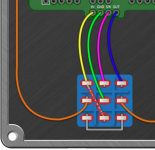Kroars
Well-known member
So, I’ve been scouring for the last couple days, read the AMZ article and combed through the forums. Found a lot of helpful tips and suggestions for solving this. My question is, what could cause switch pop when LED is engaged in a particular TS (the LGSM pcb) build, when all others have been fine?
I’ve replaced the electrolytic caps, testing prior to installation. All Nichicon from Mouser, aside from the 10uF output cap I used a Tantalum as an additional measure. I’ve replaced the foot switch with another Pro 3pdt from SBP. Reflowed all solder joints using a flux pen just to be sure. Still the problem persists.
Only pops when indicator LED is in the circuit. I could certainly add a cap and resistor as AMZ suggests. I’m just curious as to why that would happen in one build when the others work perfectly?
I haven’t replaced any of the film caps, but they’re all Wima MKS2’s from Mouser.
I can add photos later this evening. I was hoping someone could shed light as to how this happens with the indicator LED in particular.
Thanks!
I’ve replaced the electrolytic caps, testing prior to installation. All Nichicon from Mouser, aside from the 10uF output cap I used a Tantalum as an additional measure. I’ve replaced the foot switch with another Pro 3pdt from SBP. Reflowed all solder joints using a flux pen just to be sure. Still the problem persists.
Only pops when indicator LED is in the circuit. I could certainly add a cap and resistor as AMZ suggests. I’m just curious as to why that would happen in one build when the others work perfectly?
I haven’t replaced any of the film caps, but they’re all Wima MKS2’s from Mouser.
I can add photos later this evening. I was hoping someone could shed light as to how this happens with the indicator LED in particular.
Thanks!


